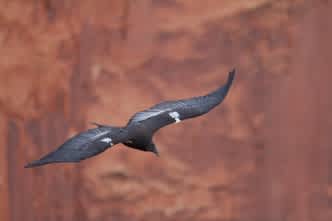Arizona Hunters Deserve Recognition for Voluntarily Reducing Lead Available to California Condors
Arizona Game and Fish Department 09.13.12

Majority of hunters in Arizona’s condor range voluntarily join lead reduction efforts
Hunters in Arizona continue to prove to the critics that voluntary efforts to conserve endangered wildlife do work, often better than mandated measures. In the last five years, 80 to 90 percent of hunters in Arizona’s condor range have taken measures to reduce the amount of spent lead ammunition that is available to California condors.
“Arizona’s voluntary lead reduction program has been well supported by hunters, and they deserve a thank you for continuing sportsmens’ proud tradition of being the nation’s first wildlife conservationists,” says Kathy Sullivan, Arizona Game and Fish Department’s condor program coordinator. “We’ve made great strides in this state and now that condors have expanded their range into southern Utah, we know where we need to focus the next steps in lead reduction efforts.”
Lead poisoning has been identified as the leading cause of death in endangered condors and the main obstacle to a self-sustaining population in Arizona and southern Utah. Studies suggest that lead shot and bullet fragments found in animal carcasses and gut piles are the most likely source of lead in condors. Many hunters do not realize that the carcass or gut pile they leave in the field usually contains lead bullet fragments. Although remains from game hunting provide an important food source for condors, several birds can be affected by feeding off of one lead-laden carcass or gut pile. By using non-lead ammunition, hunters help provide condors with an important food source to aid in their recovery.
Utah’s Division of Wildlife Resources recognizes the importance of their state in condor conservation and is launching an effort this year that is similar to Arizona Game and Fish’s.
Arizona’s condor population was reintroduced to the state under a 10(j) Rule, a special provision of the Endangered Species Act that designates the population as experimental and not essential to the species’ survival. The 10(j) rule was used to obtain acceptance among communities in Arizona and Utah and assures that “current and future land…uses…shall not be restricted due to…condors” and that the federal government did “not intend to” modify or restrict “current hunting regulations anywhere…in the experimental population area.”
“Wildlife conservation must constantly adapt and the condor program is no different,” says Sullivan. “As biologists, seeing the condors expand into Utah is gratifying and an important step in their reintroduction, but now we see where our focus needs to be in the coming years.”
Arizona Game and Fish’s lead reduction efforts are supported by the Arizona Deer Association, Arizona Elk Society, Arizona Antelope Foundation, Arizona Desert Bighorn Sheep Society, and the Arizona Chapter of the National Wild Turkey Federation.
Information on non-lead ammunition and how hunters can help is sent by mail to those drawn for hunts in condor range. For more information on condors and lead and a list of available non-lead ammunition, visit azgfd.gov/condor

